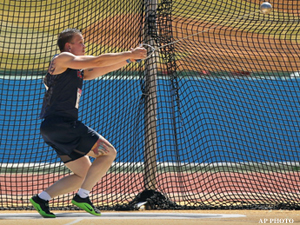
Keelin Godsey lives with his fiancée in North Adams, Mass. In June, he'll be competing for a spot on the U.S. track and field team -- the women's hammer team, to be exact.
If you're furrowing your brow, you're not alone. Godsey is a transgender athlete -- the first Olympic hopeful in the U.S. to identify as one. He has the body of a female, but strongly identifies as a male. In the latest issue of Sports Illustrated, Pablo S. Torre and David Epstein explore the slowly increasing public awareness of transgenders in sports, and the challenges Godsey has faced on his road to the Olympics.
Although he went by his given name of Kelly and wore his blond hair long at his Colorado high school, Godsey was regularly tormented for being masculine. He was viciously beat up, even by female classmates. If homosexuality is still misunderstood in our culture, then the transgendered are even more puzzling to a society hung up on gender roles and sexuality. Add sports to the equation, and it becomes even more confusing. We accept the division of men and women in sports because it typically creates the most equal playing field -- so how should professional organizations handle transgender athletes?
There was Yale tennis star Richard Raskin, who became Renée Richards in 1975. There was Kyle Allums, a guard on the George Washington women’s basketball team who came out in 2010 as a transgender. There were plenty in between. But transgender athletes have been fighting a long battle for recognition in professional sports. In 2004 the International Olympic Committee decided, in order to compete against those not of their birth sex, trans athletes have to undergo sex reassignment surgery followed by two years of hormone therapy. The NCAA followed with their own, slightly different policy. Godsey hasn’t had any hormone therapy or cosmetic surgery, so he can still compete against women, which he has always done.
"And Keelin — let's make no mistake about this, this has been incredibly tough, and at times tormenting and tortuous, for Keelin Godsey, a person who identifies fully as a male, and wishes to live as a male in all walks of life,” Torre told NPR in an interview about his Sports Illustrated piece. “But, it's his passion for sports and the opportunity to make the Olympic team" that are behind Godsey's choice.
Godsey does plan to undergo the hormone therapy and surgery necessary to fully transition to a male body, either after the Olympics or sooner, if he doesn't advance to the U.S. team.
"How long could I possibly put off going on testosterone? I'm human," Godsey told Sports Illustrated. "I'm human."
Popular Stories On ThePostGame:
-- The Truth Is Out There: Which Sports Conspiracy Can You Believe?
-- Ranking The USA Olympic Teams Since 1992
-- Rugby Player Displays Incredible Strength
-- Growing Vocal Acceptance For Gay NFL Players




